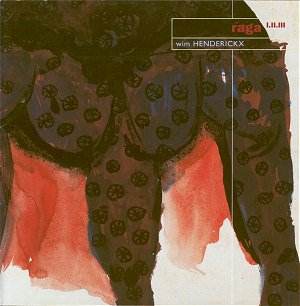Wim Henderickx, born in 1962, studied percussion and
composition (with Willem Kersters) at the Royal Conservatory of Antwerp,
and attended several Internationale Ferienkurse für Neue Musik
in Darmstadt. A good deal of his present output has been influenced
either by literary or extra-musical sources or by oriental philosophy.
This is certainly the case with his large-scale cycle Ragas under
review (each piece may however be performed separately). Henderickx
never merely imitates oriental music, but rather transfers some elements
of Indian music into Western musical terms. The three pieces roughly
share the same basic characteristics, e.g. they are all structured in
fairly symmetrical bi-partite arches and are based on simple cells progressively
developed in more complex structures. Though they were composed between
1994 and 1996, all three pieces are very different from one another:
Raga I is for percussion and orchestra, Raga II
"Tombeau" is for large orchestra and is more in the
form of a concerto for orchestra whereas Raga III is for
viola and orchestra.
In Raga I the soloist plays a wide sample
of instruments including some exotic ones such as Japanese temple bell
and other oriental instruments as well as African djembés. The
first part is predominantly lyrical, delicately scored whereas the second
one is a rhythmically busy toccata moving at great speed towards its
frantic conclusion.
Raga II "Tombeau" is the most
symmetrically structured piece of the cycle. It is based on a morning
raga. It opens in a mysterious, ethereal mood maintained for most of
the first part which nevertheless ends in a big sound wave. The second
part also begins dreamily (two solo violins supported by a few winds
punctuated by softly tinkling percussion). The music becomes more agitated
and builds up towards an impressive climax before reverting to the pensive
mood of the opening.
In Raga III for viola and orchestra,
based on a mid-day raga, the viola evokes the Indian fiddle sarangi
while the orchestra supports the soloist in tabla-like fashion. The
first part again begins dreamily, though in a somewhat darker mood.
The first entry of the viola clearly has an improvisatory character
(repeated notes, quarter-tone glissandi) before taking flight
in long melodic lines. The mood becomes more impassioned and the first
part then fades into the second one. The music now dances along with
much energy and rhythmical vitality. After a long cadenza, the music
briefly regains its impetus before reaching the peaceful, ecstatic coda
Evening Prayer.
Wim Henderickx’s music is clearly contemporary, rhythmically
complex (no wonder that the composer mentions Stravinsky and Bartok
as potent influences), though very accessible, and his remarkable orchestral
flair, gained from his experience as orchestral percussionist, is displayed
to the full in these colourful, eventful scores that, for the present
writer at least, are the peak of his present orchestral output.
In short, wonderfully inventive music in excellent
performances and warm recordings. Really well worth investigating for
Henderickx is undoubtedly one of the most endearing composers of his
generation.
Hubert Culot


